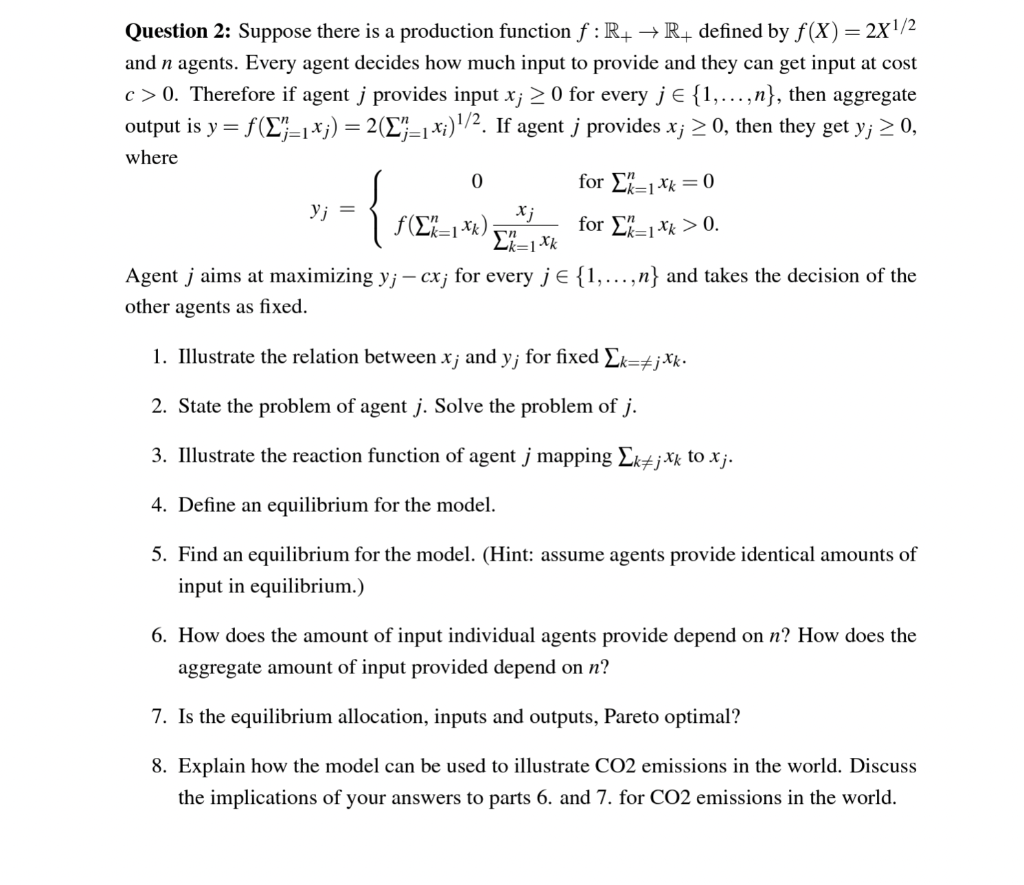
Question 2: Suppose there is a production function f:R+R+defined by f(X)=2X1/2 and n agents. Every agent decides how much input to provide and they can get input at cost c>0. Therefore if agent j provides input xj0 for every j{1,,n}, then aggregate output is y=f(j=1nxj)=2(j=1nxi)1/2. If agent j provides xj0, then they get yj0, where yj={0f(k=1nxk)k=1nxkxjfork=1nxk=0fork=1nxk>0. Agent j aims at maximizing yjcxj for every j{1,,n} and takes the decision of the other agents as fixed. 1. Illustrate the relation between xj and yj for fixed k==jxk. 2. State the problem of agent j. Solve the problem of j. 3. Illustrate the reaction function of agent j mapping k=jxk to xj. 4. Define an equilibrium for the model. 5. Find an equilibrium for the model. (Hint: assume agents provide identical amounts of input in equilibrium.) 6. How does the amount of input individual agents provide depend on n ? How does the aggregate amount of input provided depend on n ? 7. Is the equilibrium allocation, inputs and outputs, Pareto optimal? 8. Explain how the model can be used to illustrate CO2 emissions in the world. Discuss the implications of your answers to parts 6. and 7. for CO2 emissions in the world. Question 2: Suppose there is a production function f:R+R+defined by f(X)=2X1/2 and n agents. Every agent decides how much input to provide and they can get input at cost c>0. Therefore if agent j provides input xj0 for every j{1,,n}, then aggregate output is y=f(j=1nxj)=2(j=1nxi)1/2. If agent j provides xj0, then they get yj0, where yj={0f(k=1nxk)k=1nxkxjfork=1nxk=0fork=1nxk>0. Agent j aims at maximizing yjcxj for every j{1,,n} and takes the decision of the other agents as fixed. 1. Illustrate the relation between xj and yj for fixed k==jxk. 2. State the problem of agent j. Solve the problem of j. 3. Illustrate the reaction function of agent j mapping k=jxk to xj. 4. Define an equilibrium for the model. 5. Find an equilibrium for the model. (Hint: assume agents provide identical amounts of input in equilibrium.) 6. How does the amount of input individual agents provide depend on n ? How does the aggregate amount of input provided depend on n ? 7. Is the equilibrium allocation, inputs and outputs, Pareto optimal? 8. Explain how the model can be used to illustrate CO2 emissions in the world. Discuss the implications of your answers to parts 6. and 7. for CO2 emissions in the world







